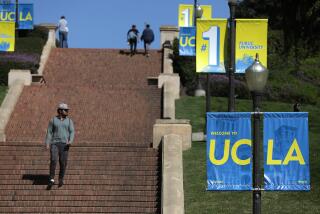The Public Ivys: A GUIDE TO AMERICA’S BEST PUBLIC UNDERGRADUATE COLLEGES AND UNIVERSITIES
- Share via
The Public Ivys: A GUIDE TO AMERICA’S BEST PUBLIC UNDERGRADUATE COLLEGES AND UNIVERSITIES by Richard Moll (Viking: $18.95; 289 pp.)
THE BEST BUYS IN COLLEGE EDUCATION by Edward B. Fiske (Times Books: $9.95, paperback; 387 pp.)
Each year, the College Board puts out a report that must send shudders through families with teen-age sons and daughters. It is a survey of the cost of going to college. The average cost was up 7% this year over last, nearly double the inflation rate. A year of study at many of the big-name campuses--Harvard, Yale, Stanford or Princeton, for example--now costs more than $15,000.
Not surprisingly, there is a market for a bargain hunter’s guide to a college education. Richard Moll, nationally respected dean of admissions at the University of California, Santa Cruz, and Edward Fiske, the education editor of the New York Times, have put together fine guides for the student or parent who is looking for a quality education with a more reasonable price tag.
Moll’s book starts with an interesting premise. Why is the most prestige in higher education accorded to private “Ivy League” colleges when the best public universities can match them in the quality of their faculties, libraries and campus life? As Moll notes, prestige in higher education is an odd combination of tradition and folklore. Membership in a sports league created in 1954--”the Ivy League”--may create an aura that leads many to believe that universities such as Cornell or Brown are somehow superior to Johns Hopkins, Duke or Stanford.
Though it is clear that many public universities can now compete in the same academic league, Moll says we don’t have a similar “pecking order” among public universities. So he set out to create a list of the “public ivys.”
First, he examined the criteria that make for a distinctive college--selective admissions, a quality education program focused on the liberal arts and enough money to buy a superb faculty and build an attractive campus.
After much consulting and campus visiting, he compiled his list of the eight best public colleges and universities in America. In alphabetical order, they are: the University of California at Berkeley, Miami University in Ohio, University of Michigan, University of North Carolina, University of Texas, University of Vermont, University of Virginia and William and Mary College in Virginia.
There’s plenty of diversity and a few surprises here. Berkeley, Michigan and Texas are huge. Vermont is small, somewhat remote and not especially well known. Miami and William and Mary seem more like small private colleges.
Moll spent several days on each of these campuses, and his descriptions of them are splendid. He has the eye of a good reporter and the ear of someone who has spent his career in college admissions work. He captures the boasts of campus administrators: “If anything, our undergraduate training is underrated,” a Berkeley official told him with a straight face. But he balances this boosterism with more candid official comments and reactions from students. For example, the students at William and Mary and at Miami point to the tough academic environment as the best quality of the college. Its worst? “It’s boring,” they say. At the bigger campuses, many students complain that it is easy to get lost for four years.
Moll also includes briefer accounts of nine runner-up universities: University of Colorado, Georgia Tech, University of Illinois, New College in Florida, Penn State, University of Pittsburgh, State University of New York at Binghamton, University of Washington and University of Wisconsin. The University of California gets special treatment, with a full description of Berkeley and shorter accounts of the seven other undergraduate campuses. With each campus description, he includes data on costs and the makeup of the student body.
The New York Times book includes the same information but covers many more colleges. A team of reporters and researchers has found more than 200 colleges that it considers relative bargains. Each gets a reasonably informative two-page account, along with the basic facts for prospective students. Listed are many small, obscure private colleges, from Berea College in Kentucky and Berry College in Georgia to Wartburg College in Iowa and Washington College in Maryland. Others are state universities, some urban and some rural. In the tradition of a good shopping catalogue, this one will convince you that there’s a good, low-cost college to suit every taste.







